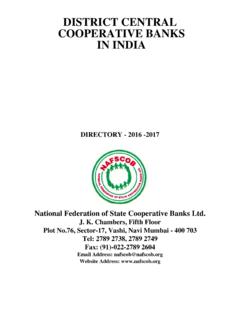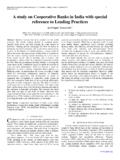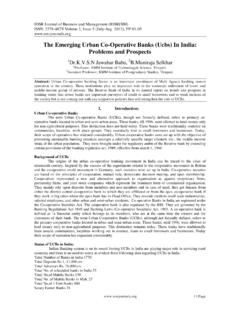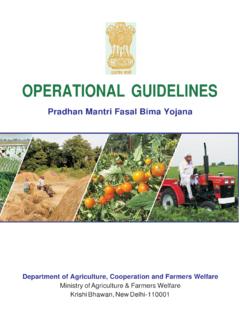Transcription of Agriculture Credit in India: An Integrated Rural …
1 International Journal of Scientific and Research Publications, Volume 2, Issue 3, March 2012 1 ISSN 2250-3153 Agriculture Credit in india : An Integrated Rural Credit Approach Krishna Kishore ORIENTAL BANK OF COMMERCE Abstract- This paper is aimed at strengthening policy reforms in the area of Agriculture Credit delivery system for the sustainability of Agriculture for food security and Rural development. In india strengthening of Agriculture is important for elimination of Rural poverty, food insecurity, unemployment and sustainability of natural resources. But till today strengthening of Agriculture was meant to be increasing productivity by introduction of high yielding seeds, application of chemical fertilizers and pesticides, mechanization and making availability of institutionalized Credit for purchasing the preceding inputs, as result the Indian Agriculture has become commercialized but not profitable to the producer.
2 This commercialization has attracted more number of middle men making the marketing channels inefficient by delivering the produce at inflated prices to the consumer and negligible margin to the producer making him indebt. This is discouraging the farmer to move towards capital intensive commercialized Agriculture practices which only can serve the future food requirements of the country. This has assumed added importance to integrate efficient marketing and Rural Credit systems. The time has come to redefine Agriculture as the Integrated activities relating to production, processing, marketing, distribution, utilization and delivered at each level individually. Agricultural Credit development strategy till today was addressing institutionalization of Credit at farmers level in marketing, trade, processing and agribusiness.
3 As a result of efforts in the Agriculture Credit delivery system, the share of private money lenders (non institutional Credit ) has decreased substantially from 93 percent in early 1950 s to 31 per cent by 1991. But showing their presence as an important and most attracted source of Credit by increasing there share to 39 percent by 2002. One main reason for this is they have been always integral part of Rural supply chain for inputs and marketing channels. The All india Rural Credit Survey (1954) has quoted that Agriculture Credit in india fell short of the right quantity , was not of the right type, did not serve the right purpose and often failed to go to the right people, even today this spells right Rural Credit with infrastructural requirements for production (input) , processing, marketing , distribution, utilization , trade with value added service like technology transfer at single point to form the Rural Credit hubs or virtual integration by utilization of the information technology create new Indian sustainable Agriculture for food security.
4 Index Terms- Agriculture Credit , Rural Credit , Integrated Credit . I. INTRODUCTION ndian Agriculture has been always in need for Credit and dependent on traditional Credit with high interest rates. This norm of high interest rate for Agriculture Credit has caused serious exploitation resulting in Rural indebtness causing serious concern over a century. This problem of providing cheap and institutionalized Credit has called attention of the British government in early 1870s. The government has started providing Credit in the form of Takkavi loans during the drought years. The first step for institutionalization has begun with the cooperative societies act in 1904.
5 Based on the report of the Maclagan Committee on Cooperation in 1915 by the end of 1930 a 3-tier cooperative Credit structure has been established in all provinces. Even The Royal Commission on Agriculture in 1926-27 emphasized on access to Rural Credit . The Reserve Bank of india Act, 1934 was passed leading to establishment of the Reserve Bank of india in 1935 like any other central banks it has specific provision for agricultural Credit . As a first step towards Rural institutionalized Credit Reserve Bank of india has conducted different studies in 1936 and 1937 and found that major share of the Credit required by the Rural community was financed by the non institutional and share of institutional Credit was negligible.
6 Until 1950 the Reserve bank has taken several steps to strengthen the cooperative societies to provide institutionalized Credit to the Rural community, a new structure was evolved to provide two types of time bound credits namely short term and loan term Credit . Despite of many measures till 1951 the institutional Credit stood at per cent of total Agriculture Credit , out of which per cent contributed by cooperatives, and per cent by commercial banks. The All india Rural Credit Survey (1954) has observed in its survey that agricultural Credit fell short of the right quantity, was not of the right type, did not serve the right purpose and often failed to go to the right people.
7 The nationalization of major commercial banks in 1969 (and in 1980) has encouraged the commercial banking system to involve in extending agricultural Credit . To encourage the neglected sectors the concept of priority sector was introduced in 1969 which included Agriculture . Even today the RBI is insisting for target of 40 percent net bank Credit towards priority sector with a sub sector target for Agriculture with 18 percent (out of which per cent for direct Agriculture and per cent for indirect Agriculture ). To have better planning at the ground level the lead bank scheme was introduced under which each district is a unit and a commercial bank with highest number of branch coverage is appointed as District lead bank to monitor and report the performance in the targeted sectors like Agriculture .
8 The green revolution has called for high Credit requirement for the purchase I International Journal of Scientific and Research Publications, Volume 2, Issue 3, March 2012 2 ISSN 2250-3153 of high yielding seeds, irrigation systems, fertilizers and chemical pesticides. Along with crop yields the cost of production has raised drastically calling huge Credit requirement. This huge Credit requirement was not met by the cooperatives or commercial banks for there own limitations. II. TRANSFORMATION TO MULTI-AGENCY APPROACH The green revolutions has commercialized the Indian Agriculture were the farmers started to depend on the inputs purchased calling for huge Credit requirement but the co-operatives lacked resources to meet the expected demand and commercial banks were not ready to lend to small and marginal farmers.
9 This called for a separate banking structure combining the local feel of co-operatives and the professionalism and large resource base of commercial banks. Following the recommendations of the Narasimham Working Group (1975), Regional Rural Banks (RRBs) were set up. Thus, by the end of 1977, there emerged three separate institutions for providing Rural Credit transforming the Agriculture Credit form Institutionalized approach to multi-agency approach . Following the recommendations of the Committee to Review Arrangements for Institutional Credit for Agriculture and Rural Development , the National Bank for Agriculture and Rural Development (NABARD) was set up in 1982 promotion of Agriculture Credit .
10 The 1991 reforms, the Rural Credit delivery system was again found to be in a poor shape ( Gupta Committee, 1998). The Report of the Committee on the Financial The Report of the Committee on the Financial System (Chairman: Shri M. Narasimham, 1991) provided the blue print for carrying out overall financial sector reforms during the 1990s. Furthermore, weaknesses in the performance of Rural financial institutions since 1991 resulted in setting up of various committees/working groups/task forces to look into their operations such as: The High-level Committee on Agricultural Credit through Commercial Banks (R. V. Gupta, 1998), Task Force to Study the Functions of Cooperative Credit System and to Suggest Measures for its Strengthening (Jagdish Capoor, 1999), Expert Committee on Rural Credit ( Vyas, 2001), and The Working Group to Suggest Amendments in the Regional Rural Banks Act, 1976 ( Chalapathi Rao, 2002).
















